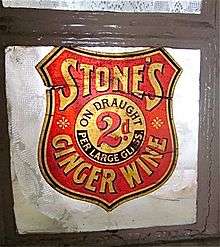Old King's Head, Kirton
The Old King's Head, Kirton in Holland, near Boston in Lincolnshire is a former public house. The earlier part of it was built at the end of the sixteenth century and was given major alterations in 1661 in Artisan Mannerist Style. It is red brick in English Bond with recent tiles over a thatched roof. It became a domestic residence in the 1960s and in 2016 it was purchased by Heritage Lincolnshire for restoration.[1]
| Old King's Head, Kirton, Lincolnshire | |
|---|---|
 The Old King's Head, Kirton, Lincolnshire | |
| Location | The Old King's Head, Kirton in Holland, near Boston |
| Coordinates | 52.927740°N 0.059105°W |
| OS grid reference | TF3054038472 |
| Built | Late 16th century (datestone 1599). |
| Rebuilt | Late 17th century (datestone 1661) |
| Architectural style(s) | Elizabethan and later Fen Artisan Style |
Listed Building – Grade II | |
| Designated | 19 November 1951 |
| Reference no. | 192093 |
 Location of Old King's Head, Kirton, Lincolnshire in Lincolnshire | |
Architecture
The term Artisan Mannerist Architecture was first used by Sir John Summerson in 1953 to describe the building style that developed after the Renaissance in Britain when artisan craftsmen such as masons and bricklayers took on the role of architects. The style was largely derived from Dutch architecture. Sir John's study was largely restricted to larger stone buildings, but John Harris who worked with Sir Nicholas Pevsner on the Lincolnshire volume of Buildings of England adopted the terminology Fen Artisan Style and described the Old Kings Head as an example of Fenland Artisan Mannerism. Harris went on to describe other examples of similar buildings. These include the nearby Blossom's Hall also in Kirton, the Elizabethan House and The Hall at Coningsby, the Porch House Sibsey the Church House at Boston and the Bulls Neck and adjacent farm near Holbeach. The style is probably best exemplified by the manor house at Aslackby, near Bourne. Here the house has raised brickwork decoration and elaborate string courses, while the square chimney stacks are angled in a line in a similar fashion to those on the Old Kings Head. The style contrasts with the Artisan brick mannerism of North Lincolnshire and Humberside which has been studied by Neave and is often associated with the work of Hull architect William Catlyn. Neave derives this architectural style from the brick architecture of the Netherlands.[2] This origin is also likely to be true for Fenland Artisan Mannerism where houses often also have Dutch gables
Old King's Head Gallery
 Old King's Head
Old King's Head Old King's Head from King's street.
Old King's Head from King's street. The Old King's Head. Mannerist brick decoration over earlier doorway
The Old King's Head. Mannerist brick decoration over earlier doorway The Old King's Head. Late 16th century moulded beam.
The Old King's Head. Late 16th century moulded beam. Advertisement for Stone's Ginger wine, c.1900
Advertisement for Stone's Ginger wine, c.1900 The Old King's Head. 17th century chimney stacks.
The Old King's Head. 17th century chimney stacks. Rear of the Old King's Head. shows brick rustication on corner.
Rear of the Old King's Head. shows brick rustication on corner.
Literature
- Antram N (revised), Pevsner N & Harris J, (1989), The Buildings of England: Lincolnshire, Yale University Press. pp. 979
- Barley M (1990) The Buildings of the Countryside 1500–1750, Vol 5, of Chapters from the Agrarian History of England and Wales (ed. Thirsk J.) Cambridge University Press, pp 1–173.
- Neave D. (1996) Artisan Mannerism in North Lincolnshire and East Yorkshire: The work of William Catlyn (1628-1709) of Hull in Sturman C (ed) Lincolnshire Peoples and Places: Essays in Memory of Terence R. Leach (1937-1994), pp. 18–25.
- Summerson Sir J 1953, Architecture in Britain 1530-1830, 97-105
References
- The Old King's Head gets a new lease of Life
- Neave (1996), pp18-25
External links
| Wikimedia Commons has media related to The Old King’s Head, Kirton, Lincolnshire. |
| Wikimedia Commons has media related to Artisan mannerist architecture. |